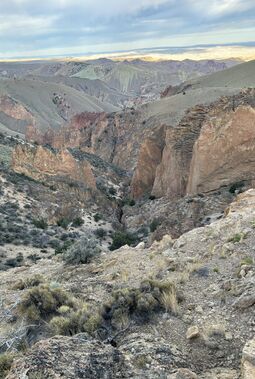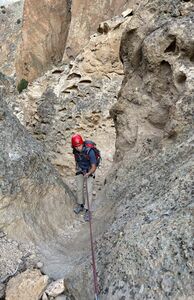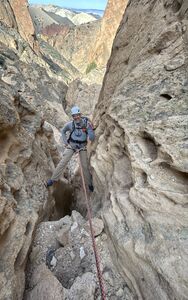Upper Lesslie Gulch (Top Down)
| Rating: | |||||||||||||||||||||||||||||||
|---|---|---|---|---|---|---|---|---|---|---|---|---|---|---|---|---|---|---|---|---|---|---|---|---|---|---|---|---|---|---|---|
| | Difficulty:3A II PG (v4a1 V) Raps:2+, max ↨150ft
Red Tape: Shuttle:Optional 20 minutes Vehicle:Passenger Rock type:Volcanic Ash | ||||||||||||||||||||||||||||||
| Start: | |||||||||||||||||||||||||||||||
| Parking: | |||||||||||||||||||||||||||||||
| Condition Reports: | 12 Oct 2025
"Completed this canyon with (4) others, (2) of which we randomly ran into at the TH.. Ascent follows a well traveled trail, you then cut off and ga |
||||||||||||||||||||||||||||||
| Best season: | Jul-Sep (avg for this region)
|
||||||||||||||||||||||||||||||
| Regions: | |||||||||||||||||||||||||||||||
Introduction[edit]
This canyon is a technical slot canyon in Leslie Gulch. From the Upper Leslie Gulch trailhead, it took a group of five 4.5 hours to complete the route with setting webbing on the rappels. There are two rappels. The first has a string of boulders before the drop to sling. The second has a big chockstone about 40ft back of the drop to sling. The second rappel is two stages, so don't pull your rope at the bottom of the first drop. From webbing with virtually no run out around the big chockstone to the bottom of the second stage will take 143ft (not including pull). If you choose to fiddle stick the chockstone, a 150ft rope may just get the job done (not including pull). Even though the rope goes around a bend in the canyon, it pulled down without issue. This drop goes into a room where three canyons converge. Beyond the long drop, there are a few downclimbs that some may want to rappel to 10ft or so. Elbow pads are highly suggested for these downclimbs. A fiddle stick will work extremely well on these two drops if you don't want to leave webbing. Bolting isn't really an option in this rock, so leave your drill at home. The compressed ash in other sections of Leslie Gulch is much harder than in this canyon.
The North fork entrance has a maze of canyons. The middle drainage of three has been descended and required a 60ft rappel from a giant chockstone. Webbing was used as testing a pull of rope around the chockstone was not going well for use of a fiddle stick. The other two slots have rappels of close to the same height, but have not been done.
Approach[edit]
You can drive to the scree slope that is at the beginning of the canyon, but you need a vehicle with good clearance and off-roading tires, because the road is more of a lightly used trail. You could avoid the big climb with a shuttle if you so choose.
Another option is to park at the Upper Leslie Gulch trailhead and hike to the bottom the canyon, as the KML shows.
Descent[edit]
The main fork has two rappels of 20 ft and 150 ft.
Exit[edit]
You can start and finish at the Upper Leslie Gulch trailhead, at the top of the canyon with a high clearance vehicle, or do a shuttle between the two.
Red tape[edit]
Beta sites[edit]
Trip reports and media[edit]
Pictures from the North Fork entrance: https://www.facebook.com/share/p/14MqsFk5VmP/


